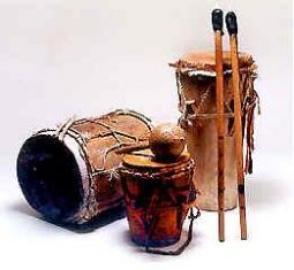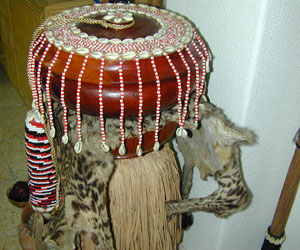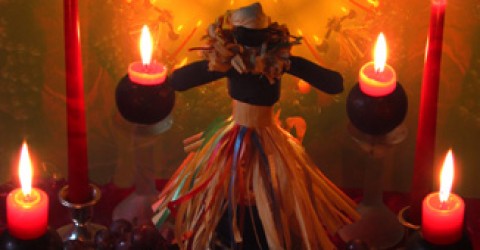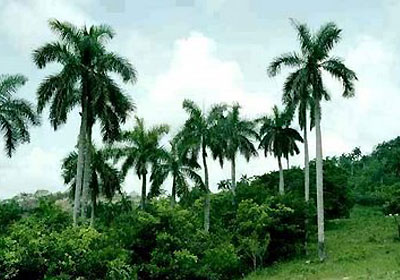In the 19th Century in Cuba the historian Fernando Ortiz counted the presence of over one hundred different African ethnic groups, and estimated that by the end of that century fourteen distinct “nations” had preserved their identity in the mutual aid associations and social clubs known as cabildos, societies of free and enslaved blacks from the same African “nation,” which later included their Cuban-born descendants.
Between 1835 -1864 the slave trade with the West coast of African exploded, and it is estimated that almost 400,000 Africans were brought to Cub. [That’s roughly 1150 per month for 29 years!] In 1841, African slaves made up over 40% of the total population of Cuba. Four major Afro-Cuban divisions (Lucumí, Arará, Abakuá, Kongo) are represented in Cuba.
We’ll start with:
CONGO (Kongo)
Of all the collective terms used to specify Afro-Cuban origins, “Kongo” encompasses the greatest diversity of peoples brought to Cuba during the years of slavery. The names of the myriad Cuban Kongo cabildos reflect the geography of the slave trade or else include African ethnic designations. Sometimes they bore the names of slaving ports (Loango, Benguela and Cabinda, the last also very important for Brazil), and sometimes they specified clan origins, such as the Nsobo (Bazombo) and Mayombe (Yombe),who also gave their name to a Cuban-Kongo religion. Members of one surviving Kongo cabildo, San Antonio de los Congos Reales in the old colonial city of Trinidad, are still performing such archaic pantomime dances as the Danza de la Culebra (Serpent Dance), which was well known in colonial Havana as Matar la Culebra (Killing the Snake), and was performed by Kongo comparsas on January 6, the Day of the Kings. Many forms of contemporary Cuban music, including many of the rumba and carnival styles, are full of Kongo references and influences and display continuity with older Kongo forms.
The most common form of secular Kongo music during the 19th century incorporated the use of Yuka drums. Played in groups of three, they were made by hollowing out tree trunk sections of various sizes and nailing on cowhide heads. The largest and master drum is called the caja [Kah-Hah], which in typical Kongo fashion is held between the legs of the drummer. Another musician plays a pair of sticks against the body of the caja, often on a piece of tin that has been nailed to the base of the drum. This stick is called the guagua or cajita, which may also be played on a separate instrument. The middle drum is called the mula [Mu-Lah], and the smallest is the cachimbo [Kah-Cheem-Bo]. A guataca is played as a time-keeper, and the caja player often wears a pair of wrist rattles.Yuka dancing featured the vacunao, a pelvic movement also found in Kongo-derived dance styles elsewhere in the Americas.
During the years of slavery, sugar estate owners would often sponsor Sunday festivals, called conguerías, and invite slaves from neighboring centrales to participate. Besides yuka drumming, which can still be found in some parts of rural Cuba, they featured song contests between competing soloists, called gallos, as well as makuta dances and maní, a now obsolete combat dance roughly similar to Brazilian capoeira.
After the Haitian revolution, many refugees, including French planters and their slave, fled across the narrow Windward Passage to eastern Cuba, where they established coffee plantations in the highlands around Santiago de Cuba. In that city and in Guantánamo, some of their former slaves and their descendants, who had clung to their Afro-Haitian culture, established their own cabildo-like associations, known as tumba francesa, or “French drum.” There they played Haitian-style drums and performed dances with names such as masón and yubá (juba), similar to those found in Haiti today, and sang in Creole.
YORUBA (Oloku mi)
Cuba’s transformation into a sugar-growing island is intimately linked via the slave trade to African history. It coincided with the collapse of the Oyo empire of Nigeria after decades of internal strife among the Yoruba and warfare with their Fulani neighbors to the north and Dahomeans to the west. Many Yoruba were taken to Cuba very late in the slave trade, especially during the years 1820-1840, when they formed a majority of [Africans] sent across the Atlantic from the ports of the Bight of Benin. The included several Yoruba-speaking subgroups, including the Ketu, Ijesha, Egbado, Oyo, Nago and others.
In Cuba, Yoruba speakers became known by the collective term Lucumí, after a Yoruba phrase, oloku mi, meaning my friend. As a result of slavery, the lineages and kin groups that had supported worship of the various orisha were disrupted. A new religion called santería arose, which grouped together many orisha, each of which became identified with a Catholic saint on whose day festivals would be held. From the ethnically-based cabildos of colonial Cuba, santería became organized into individual “houses,” known as casas de ocha. It has since spread far beyond its original ethnic base, both within and outside of Cuba.
Entry into santiería is through a long process of initiation, during which an orisha is seated in the head of an iyawó, or initiate. As in other African-based religions in the Americas, music plays a critical role in bringing the orisha to dance in the heads of the initiates, and in creating and sustaining the ritual setting. The most sacred instruments among the Lucumí are the trio of batá drums, which when consecrated are called fundamento and are said to hold an indwelling deity called Añá. Batá are played at initiation ceremonies, in the presentations of initiates to the drums, at funerals, in ceremonies honoring the ancestors and in others that call for sacralized drums. Other Lucumí styles include ensembles of beaded gourds, known as abwe or chekeré, which are played, for example, in ceremonies celebrating ritual “birthdays;” and sets of bembé drums, usually cylindrical in shape, which may show non-Yoruba influences and are usually found in rural areas.
In the 1950s there was an increased infusion of Lucumí ritual styles and subject matter into the Cuban popular music mainstream. One important event was the release of an LP called Santero, which featured batá drummers from the Havana area and such popular singers as Mercedes Valdes, Celia Cruz and others, all singing in Lucumí. Celia Cruz and Gina Martin also recorded songs in conjunto format that were homages to different orisha. More recently, the Cuban group Mezcla, featuring the great akpon (Lucumí song leader) Lázaro Ros, has been recording a new ritual-popular music, some in the style of French Caribbean zouk, some influenced by jazz and rock.
Batá are a set of three double-headed, hourglass-shaped drums. The largest iyá (mother), [E-Yah], is the master drum. The iyá calls the rhythms in, calls changes and conversations. Next in size, the itótele (means: follows completely), [E-Toe-Teh-Lay], follows the direction of the iyá answering the conversation calls and rhythm changes. The smallest drum okónkolo [O-Kon-Ko-Lo], sometimes referred to as Omele [O-May-Lay (strong child)], , for the most part plays ostinato patterns, also changing rhythms from the calls of the iyá.
Sources: AfricanLinks/InternetPhotos/www.thecubanhistory.com
AFRO-CUBANS Identities. History
The Cuban History, Arnoldo Varona, Editor
IDENTIDADES AFRO-CUBANAS. Historia.
En el siglo 19th, en Cuba el historiador Fernando Ortiz contó la presencia de más de un centenar de diferentes etnias africanas, y estima que a finales de ese siglo catorce distintas “naciones” había conservado su identidad en las asociaciones de ayuda mutua y clubes sociales conocidos como cabildos, las sociedades de negros libres y esclavos de la misma ” nación”, africana, que incluyó más tarde sus descendientes nacidos en Cuba .
Entre 1835 -1864 el tráfico de esclavos con la costa oeste de África explotó, y se estima que casi 400.000 africanos fueron traídos a Cuba. [ Eso es más o menos 1150 por mes durante 29 años !] En 1841 , los esclavos africanos representaban más del 40 % de la población total de Cuba . Cuatro grandes divisiones afrocubanos ( Lucumí , arará , abakuá , Kongo ) están representados en Cuba.
Vamos a comenzar con:
CONGO
De Todos los colectivos de Términos utilizados párrafo especifícalo los Orígenes afro – cubanos , ” Kongo ” Abarca la Mayor Diversidad de pueblos traidos a Cuba Durante Los Años de Esclavitud . Los NOMBRES de los miles de cubanos cabildos Kongo reflejan la geografía de la Trata de Esclavos Africanos , o bien INCLUYEN designaciones étnicas . A veces sí llevaban los NOMBRES de los Puertos esclavistas ( Loango , Benguela y Cabinda , El último also es muy Importante párr Brasil) , ya veces sí especifican los Orígenes del clan, COMO EL Nsobo ( Bazombo ) y Mayombe (Yombe), Que also Dieron Su Nombre a una religión cubana – Kongo . Los Miembros de las Naciones Unidas Superviviente cabildo Congo , San Antonio de los Congos Reales en la antigua ciudad colonial de Trinidad , TODAVIA SE ESTAN ESTAS Realizando danzas de pantomima arcaicas Como la Danza de la Culebra ( Danza de la Serpiente ) , Que era muy Conocido en La Habana colonial , Como Matar la Culebra ( matar a la serpiente ) , y FUE realizada porción Kongo comparsas del 6 de enero , el Día de los Reyes. Muchas Formas de la Música Cubana Contemporánea , Entre Ellos MUCHOS de la rumba y los Estilos de carnaval , Estan Llenas de referencias e Influencias Kongo y mostrar la Continuidad con las Antiguas Formas de Kongo.
La Mas -forma Común de la Música profana Kongo en el Siglo 19 incorporó el USO de los tambores de Yuka . Se Juega en Grupos de tres, Que were Hechas Por vaciamiento Secciones tronco de Varios TAMAÑOS y clavos en las cabezas de cuero de vaca . El tambor mayor y el capitán Llama del SE de la caja [ Kah- Hah ] , Que a la Manera típica de Kongo sí lleva a cabo Entre las PIERNAS de la Batería. Otro músico toca sin par de palos contra el Cuerpo de la caja , una en el menudo sin Trozo de estaño Que se ha clavado en la base de del tambor . Este palo Llama del SE de la guagua o cajita , Que also sí pueden Reproducir En Un Instrumento Separado . El tambor del Medio Llama del SE de fórmula [ Mu – Lah ] , y El Mas Pequeño es el cachimbo [ Kah- Cheem -Bo ] . Un Guataca sí Juega Como un guardián del Tiempo, y el Jugador caja lleva el menudo sin par de muñecas bailando rattles.Yuka conto con la vacunao , UN MOVIMIENTO DE LA pelvis TAMBIEN SE encuentran es Kongo – Derivados Estilos de la Danza es Otras contradictorio del Continente americano .
Durante Los Años de Esclavitud , los Dueños de los centrales azucareros a Menudo Patrocinan festivales dominicales , Llamados conguerías , e invitar a los Esclavos de centrales Vecinos a Participar . Ademas de tambores yuka , Que todavia sí pueden ENCONTRAR en algunas Zonas rurales de Cuba , Que conto con concursos de canto Entre los solistas Que compiten , Llamados gallos , Asi Como bailes Makuta y Maní, sin baile de combate de han quedado obsoletas o Menos similares a la capoeira Brasileña .
Despues de la revolución haitiana , MUCHOS Refugiados , INCLUIDOS los colonos Franceses y Sus Esclavos , huyeron a Través del Paso de los Vientos estrecho párrafo el Este de Cuba , where establecieron Plantaciones de café en las tierras altas de los alrededores de Santiago de Cuba . En la ESA ciudad y en Guantánamo , algunos de Sus Antiguos Esclavos y Sus Descendientes , Que se habia aferrado un su cultura afro – haitiana , establecieron sos Propios cabildo -Como las Asociaciones , Conocido Como tumba francesa , o ” tambor Francés” .
Alli actuaban al Estilo de Haití tambores y bailes con NOMBRES COMO masón y Yuba ( Juba) , Similares a las Que se encuentran en Haití , y Canto en creole .
YORUBA ( Oloku mi)
La transformación de Cuba en una isla de azúcar cada vez está íntimamente ligado a través de la trata de esclavos en la historia africana. Esto coincidió con el colapso del imperio de Oyo Nigeria después de décadas de luchas internas entre los Yoruba y la guerra con sus vecinos Fulani en el norte y Dahomeans al oeste. Muchos Yoruba fueron llevados a Cuba muy tarde en la trata de esclavos , especialmente durante los años 1820-1840 , cuando se formaron la mayoría de [ los africanos ] enviado a través del Atlántico desde los puertos del golfo de Benín . El incluido varios subgrupos de habla yoruba , entre ellos el Ketu , Ijesha , Egbado , Oyo , Nago y otros.
En Cuba , los oradores Yoruba fueron conocidos por el término Lucumí colectiva , después de una frase Yoruba , oloku mi, es decir, mi amigo. Como resultado de la esclavitud, se rompieron los linajes y grupos familiares que habían apoyado la adoración de los diversos orisha . Una nueva religión llamada santería surgió , que agrupa a muchos orisha , cada uno de los cuales se identificó con un santo católico en cuyo festivales días se celebraría . A partir de los cabildos de base étnica de la Cuba colonial , santería fue organizado en individuales ” casas”, conocidas como casas de ocha . Desde entonces se ha extendido mucho más allá de su base étnica original, tanto dentro como fuera de Cuba .
Entrada en santiería es a través de un largo proceso de iniciación, en el que un orisha se asienta en la cabeza de un Iyawó o iniciar . Al igual que en otras religiones de origen africano en las Américas , la música juega un papel fundamental en lo que el orisha a bailar en la cabeza de los iniciados, y para crear y mantener el valor ritual. Los instrumentos más sagrado entre los Lucumí son el trío de tambores batá , que cuando está consagrada se llama Fundamento y se dice que tienen una deidad que mora llamada Azaña. Batá se reproducen en las ceremonias de iniciación , en las presentaciones de los iniciados a los tambores , en los funerales, en las ceremonias en honor a los antepasados y en otros que requieren de tambores sacralizados . Otros estilos Lucumí incluyen conjuntos de cuentas calabazas , conocidos como capaz o chekeré , que se juegan , por ejemplo, en las ceremonias rituales que celebran ” cumpleaños “, y conjuntos de tambores Bembe , generalmente de forma cilíndrica, que pueden mostrar influencias no Yoruba y son normalmente se encuentran en las zonas rurales .
En la década de 1950 se produjo un aumento de la infusión de estilos rituales Lucumí y temas en la corriente principal de música popular cubana . Un acontecimiento importante fue el lanzamiento de un LP llamado Santero , que contó con tambores batá de la zona de La Habana y cantantes tan populares como Mercedes Valdés , Celia Cruz y otros, todos cantando en Lucumí . Celia Cruz y Gina Martin también grabaron canciones en formato Conjunto que son homenajes a diferentes orisha . Más recientemente, el grupo cubano Mezcla , con la gran akpon ( director de cantos Lucumí ) Lázaro Ros, ha estado grabando una nueva música ritual popular, algunos en el estilo del francés del Caribe zouk , algunos influidos por el jazz y el rock.
Batá son un conjunto de tres tambores de doble cabeza , con forma de reloj de arena . El mayor iyá (madre ) , [E -Yah ] , es el tambor principal. El iyá llama a los ritmos , las llamadas cambia y conversaciones. Siguiente en tamaño, el itótele ( significa: sigue completamente ) , [E -Toe -Teh -Lay ] , sigue la dirección de la iyá responder a las llamadas de conversación y los cambios de ritmo. El tambor más pequeño Okónkolo [O- Kon -Ko- Lo] , denominado a veces Omele [O -May- Lay ( hijo fuerte) ] , en su mayor parte reproduce patrones ostinato , cambiando también los ritmos de las llamadas de la iyá .
Sources: AfricanLinks/InternetPhotos/www.thecubanhistory.com
AFRO-CUBANS Identities. History
The Cuban History, Arnoldo Varona, Editor



 * * AFRO-CUBANS Identities. KONGO and YORUBA History. (Photos) * * IDENTIDADES AFRO-CUBANAS. Kongo y Yoruba Historia (Fotos).
* * AFRO-CUBANS Identities. KONGO and YORUBA History. (Photos) * * IDENTIDADES AFRO-CUBANAS. Kongo y Yoruba Historia (Fotos).



